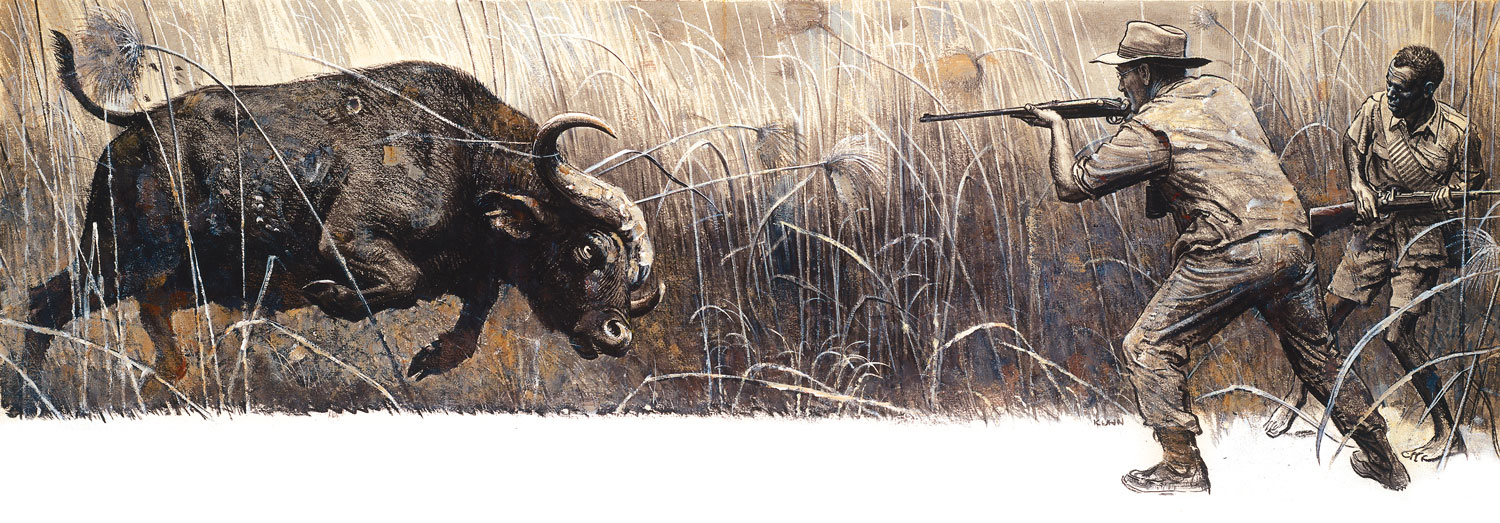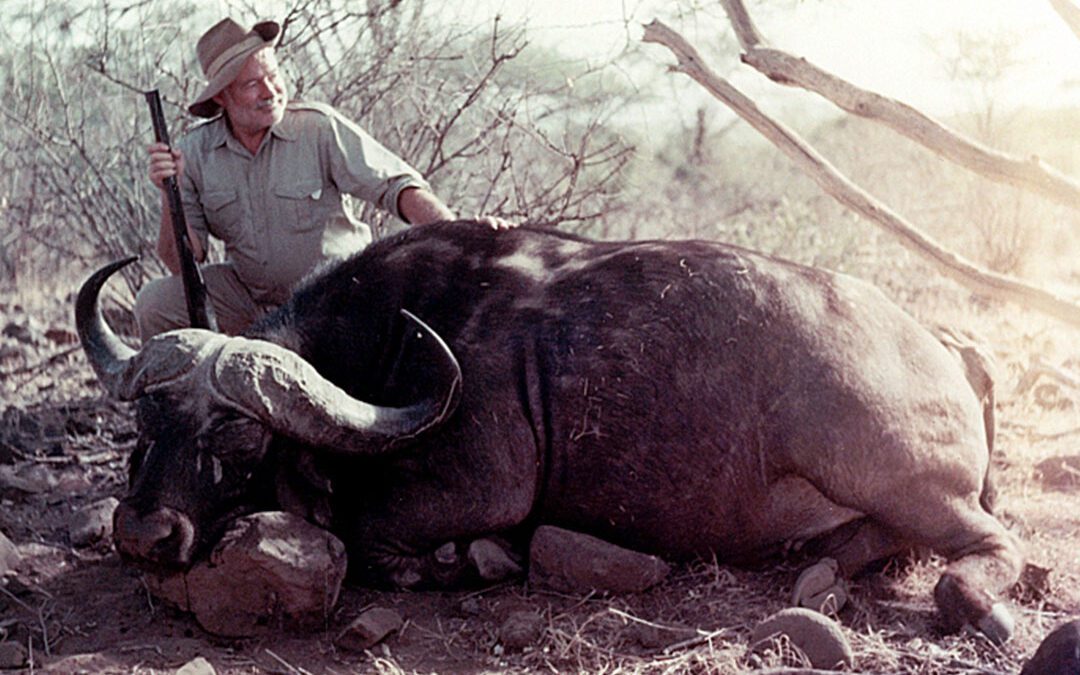This article originally appeared in the July 1934 issue of Esquire magazine.
In the ethics of shooting dangerous game is the premise that the trouble you shoot yourself into you must be prepared to shoot yourself out of. Since a man making his first African shoot will have a white hunter, as a non-native guide is called, to counsel him and aid him when he is after dangerous animals, and since the white hunter has the responsibility of protecting him no matter what trouble he gets into, the shooter should do exactly what the white hunter tells him to do.
If you make a fool of yourself, all that you get is mauled but the white hunter who has a client wounded or killed loses, or seriously impairs, his livelihood. So when the white hunter begins to trust you and let you take chances, that is the mark of confidence and you should not abuse it. For any good man would rather take chances any day with his life than his livelihood and that is the main point about professionals that amateurs seem never to appreciate.
There are two white hunters in Africa who not only have never had a client mauled—there are many such, but these two have never been mauled themselves; and there are very few of these. It is true that Philip Percival had a buffalo die with his head in the now ample Percival lap, and that Baron von Blixen, if there were any justice for elephants, would have been trampled to death at least twice. But the point is that they do not get mauled and that their clients get record heads, record tusks and super lions year after year. They simply happen to be super hunters and super shots. (There are too many supers in these last two sentences. Re-write them yourselves lads and see how easy it is to do better than Papa. Thank you. Exhilarating feeling, isn’t it?)
Both mask their phenomenal skill under a pose of nervous incapacity which serves as an effective insulation and cover for their truly great pride in the reserve of deadliness that they live by. (All right now, better that one. Getting harder, what? Not too hard you say? Good. Perhaps you’re right.) Blix, who can shoot partridges flying with a .450 No. 2 Express rifle will say, “I use the hair trigger because my hand is always shaking so, what?” Or, stopping a charging rhino at ten yards, remarking apologetically to his client who happened to have his rifle already started back to camp by the gunbearer, “I could not let him come forever, what?” (You see, this is where Papa scores. Just as you learn to better one of those awful sentences, with too many supers or too many verys in it and you think he’s gone wa-wa on you, you find that it is the thing he is writing about that is interesting. Not the way it’s written. Any of you lads can go out there and write twice as good a piece, what?)
Philip, who swears by the .450 No. 2 as the only, or at least lightest, stopper for a man to use on animals that will “come” killed all of his own lions with a .256 Mannlicher when he had only his own life to look after. I have seen him, careful, cautious, as wary about procedure as Saleri, Marcial Lalanda, or any of the old masters of chance controlling, light up like a schoolboy at the approach of vacation, when all the safe and sane methods were finally exhausted or rendered impractical and there was no choice but to go in after him as he went in after them in the old days before it was a matter of the safety of the client. (Excuse me, Mr. P. You see I do this for a living. We all have to do a lot of things for a living. But we’re still drinking their whiskey, aren’t we?)
Many people want not to shoot but to have shot dangerous game. These people, regardless of their means, usually make the African shoot only once, and their white hunter usually fires as many or more shots than his client does. A very good standard by which to judge your real effectiveness against buffalo, rhino, elephant, lion and leopard is to keep track of how many times your white hunter shot on the safari. (You shot twice, Mr. P. Correct me if I’m wrong. Once at that leopard’s mate when she broke back and you spun her over like a rabbit, and the other time when we caught the bull in the open and had two down and the third bull with four solids in him going at that same gallop, all one solid piece, the neck a part of the shoulders, dusty black and the horns blacker, the head not tossing in the gallop. You figured he would make the bush so you shot and the gallop changed into a long slide forward on his nose.)
Philip Percival ranks leopard as more dangerous than lion for these reasons. They are nearly always met unexpectedly, usually when you are hunting impala or buck. They usually give you only a running shot which means more of a chance of wounding than killing. They charge nine times out of ten when wounded, and they come so fast that no man can be sure of stopping them with a rifle. They use their claws, both fore and hind when mauling and make for the face so that the eyes are endangered, whereas the lion grabs with the claws and bites, usually for the arm, shoulders or thigh. The most effective stopper for a leopard is a shotgun and you should not fire until the animal is within ten yards. It does not matter what size shot is used at that range. Birdshot is even more effective than buckshot as it hangs together to blow a solid hole. (Mr. P. took the top of the head off one once with a load of number sevens and the leopard came right on by and on for fifteen yards. Didn’t know he was dead it seems. Tripped on a blade of grass or something finally.)

Personally, so far, and it is from a very minute quantity of experience indeed—the killing of four of them—I cannot see the buffalo as comparing in dangerous possibilities to either lion or leopard. We twice saw lion catch and kill wildebeest. This is a very rare thing. Philip Percival had seen lion kill only once before in all his year of hunting. It was while he was out with Mr. Prentiss Gray, who recorded the occurrence, I believe. The sight of that speed, that unbelievable smooth rush the lioness made to close the gap between herself and the fast galloping, though ungainly, antelope made me see what a charge from a slightly wounded lion could be if allowed to get under way.
The buffalo, on the other hand, seemed unbelievably slow compared to a Spanish fighting bull, and I see no reason why a man who could wait for him as he came could not be sure of blowing the front of his head in if he let him get that close and shot carefully with a heavy enough rifle. Certainly a tunnel in thick bush, or high reeds, or any dense cover can make the wounded buffalo dangerous, but that is a case of circumstances rather than the animal, and in the same circumstances a lion would be much more deadly. In the open a lion or leopard is a hundred times more dangerous.
The buffalo has courage, vindictiveness and an incredible ability to absorb punishment but I believe that in the bull ring he would be more like a big truck that comes charging in during the intermission to water the dusty sand than like the light hoofed, quick whirling, fast charging fighting bull.
Of course, he is not an animal of the open and you must take him where you find him and follow him where he goes, and he goes into bad places, but the point was to compare the inherent danger in the actual animals on an equal terrain—not in the peculiar circumstances under which he must be dealt with. (There won’t be any more asides you will be glad to hear. Am going to write Mr. P. a letter instead. The asides were put in when I read this over on the boat. Got to missing him.)
To me, also, and the experience it must be again stated is profoundly limited, the rhino is a joke. He may be a bad joke, too, but his atrociously poor eyesight gives the hunter an advantage over him that his bulk, his really remarkable speed and agility, and his sometimes idiotic pugnacity cannot overcome unless aided by advantage of terrain. Many times the rhino will have this advantage which will usually consist in encountering him on one of the paths or tunnels he has made through otherwise impossible tall grass and bush, and then he is as dangerous as a vindictive, horned, locomotive. He is, too, very fast. I believe he is faster than a buffalo. But fundamentally, to me, he seems a dangerous practical joke let loose by nature and armed with a horn which the Chinese pay high prices for to grind up and use as an aphrodisiac, and the pursuit of which by white and native hunters has made him shy and furtive in his habits and driven him from the plains to the broken hills and high mountain forests—where he can grow his horn and browse in peace, and where, incidentally, he is much better hunting.
Elephant I have never shot so I cannot write of them even to give the questionable impressions of the greenhorn. We plan to go out again to Kenya for six months next year to try to get a really good one, to hunt buffalo and rhino, and to see how far wrong first impressions of these were, and to try to get a good bull sable. Meantime, I know nothing about elephant from personal experience, and since notes on dangerous game by a man who has never hunted elephant are like campaign impression of a bloke who has never seen a major engagement, that is the sort of notes these notes will have to be.
(There turns out to be one more of these. One night when we were eating supper at Mombasa after fishing, A.V. and Mr. P. and I were talking about writing these letters and I suggested Alfred write one about hunting elephant with Blix before he started to write on racing. I was writing on rhino and buffalo, etc., I said. Mr. P. got so excited that his legs shook, he screwed the reel brake backwards until it stuck, he had a dolphin jumping into, and out of, and over the boat. Sometimes he jerked the bait out of their mouths; occasionally he let them swallow it, but always he had a dolphin jumping on his line.
“How do you like it, Pop?” I asked him.
“God,” he said, “I haven’t had so much fun since the day you shot the buffalo.”
Then, a little later, “I’m going to write an article on it for Esquire. Call it ‘Dolphin Fishing by One Who Knows.’”)

